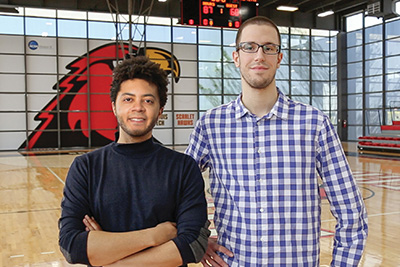
They Got Aim
Photo: Christian Lantry
W
ith 14 seconds left in the game, fans in the courtside crowd at Penn State Fayette’s Bryce Jordan Center were on their feet as opposing teams of student-athletes strategically positioned themselves on the polished basketball court in the March 4 event. During second 14, Illinois Tech guard #12, Quentin Forberg, leapt high to make his only basket of the game, one that he will likely never forget. His three-point shot will be remembered as the final points scored in an historic game for the Scarlet Hawks—the team’s first United States Collegiate Athletic Association Division I National Basketball Championship qualification. Although Illinois Tech ultimately lost to the Concordia College Alabama Hornets, the true glory lies in the Hawks’ journey and their supportive team-behind-the-team—composed of a dedicated coach, loyal fans, family members, and a trio of creative data analysts.
Men’s Basketball Head Coach Todd Kelly knew that he faced a challenging situation when he came to Illinois Tech in 2014. Basketball had been reinstated as a varsity sport only two years earlier, and the majority of the 11-man team Kelly inherited had never even played high school basketball. During Kelly’s first year, the Hawks won two games. Even with a core of power shooters such as Anders Bybjerg (BA ’17), Samuel Rarick (EE/M.S. CE 5th year), and Vignesh Rajagopal (EE ’17), Kelly was certain the team’s 4–21 finish during the 2015–16 season simply did not reflect the players’ full capabilities.
The coach’s frustration rose to the surface one day in late February 2016 as he walked through the Keating Sports Center weight room and noticed Rarick and another player studying the pulleys and iron stacks.

Photo: Malik Howze
“I asked them what they were doing and they told me they were discussing the tension in the system,” recalls Kelly. “I immediately told them they should be lifting the weights, not trying to figure out how the machine works.”
After going back to his office, Kelly still had the two student-athletes on his mind when an energy-efficient lightbulb went off. For years he had been fascinated by the movie Moneyball and the annual MIT Sloan Sports Analytics Conference. Why not see if Illinois Tech’s STEM-focused students could calculate some of the advanced statistics and player lineups used by the National Basketball Association and Division I teams to help the Hawks fly out of their slump?
Kelly first discussed the idea with his wife, Adrianne, then met with Shlomo Engelson Argamon, professor of computer science and director of Illinois Tech’s Master of Data Science program, who recommended his two sports-minded data analytics graduate students for the project: Denis Bajic (AMAT, CS ’15), an analytics extrovert, and Larry Layne, his quieter counterpart who earned his first master’s degree, in chemistry, from Carnegie Mellon University.
“Data analytics is much more challenging in basketball than in baseball, where it all started,” Argamon explains. “Baseball is a comparatively static, slow-moving game—the effect of an individual player on what’s going on in the game is relatively independent of what the other players are doing. In basketball there are multiple players on the court at the same time, the game moves very quickly, and there is a lot of interaction between the players. One player makes the basket, but the other players on the court can all influence the setup for that scoring. Those interactions make it much more complicated and difficult to calculate the kinds of statistics that are going to be helpful to a coach.”
“At Illinois Tech, we have tremendous potential to find innovative academic answers to athletics questions. Athletics shouldn't exist in a vacuum where we don’t use that potential to figure out how to do things better,”
— Joe Hakes, director of athletics.
Each week during their summer 2016 practicum, Bajic, who graduated from the master's program this May, and Layne met with Argamon and Kelly to discuss their findings. At the conclusion of the project, the duo provided Kelly not only with all of the statistics that he requested and more, but also the foundation for a creative complement: game simulations. Layne, a video game enthusiast, attempted simulations of future games to extract potentially useful information. He says that he logged so many computer hours analyzing Hawks players that at one point during the academic year he passed another student on Mies Campus who looked familiar, realizing afterward that he was one of the basketball players.
Though the data science graduate students who helped give the student-athletes a game leg up had not met them (before the IIT Magazine photo that accompanies this article), their eagerness to become involved is one example of an esprit de corps moment, perhaps more meaningful than even a trophy. Rarick, one of five Hawks honored by the Association of Division III Independents (AD3I) this year, says the combined efforts provided players with a competitive edge.
“I am extremely thankful to those students who helped us out; I believe that data analytics can be a useful tool in preparing for games and devising strategies in-game,” he says. “Players learned one another’s tendencies and grew as a cohesive unit. Using both data analytics to prepare and having good team cohesion only increased our chances of winning. I believe those are two integral factors into why we did well this season.”
Kelly, named 2017 Coach of the Year by the AD3I, recalls other moments, such as when his wife surprised him with a 1:30 a.m. knock on his hotel door the morning of the championship, having driven eight hours to join him in cheering on the Hawks. Kelly also thinks about the team’s most dedicated, fist-pumping fan, basketball letterman John G. Olin (ME ’61), Techhawks forward #43.
“When I look back on my own days on the basketball team, I recall the camaraderie and the teamwork. We also learned how to win, how to lose with poise, and how to lead,” says Olin. “Our team this year learned all of those things.”
Argamon, the basketball novice who admits to never having been a sports fan, describes the overall victory for the university community.
“We’ve contributed some insight from data analytics; Coach Kelly used that to motivate his players, improve their strategies, and take them to the next level,” he says. “There’s a message here: Illinois Tech, historically, has emphasized interdisciplinary education and research—it’s how we do everything. This is a great success story for that way of approaching the world.”
